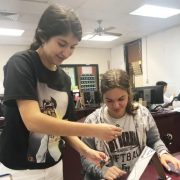Let’s Praise the Number Pi on Pi Day, March 14th
Many educational tools have gone out of fashion in the past few decades. A partial list includes the blackboard, the slide rule, the so-called New Math, the study of cursive penmanship, the mimeograph machine, carbon paper, dot matrix printers, slide projectors, and screaming modems.
Yes, lots of things have come and gone. But there is one thing that students still need to know about and use . . .
The number Pi (represented by the Greek letter π)
Pi will absolutely, positively never go away. One reason is that due to its innate mathematical soundness, nothing will ever replace it or prove it is wrong.
A Quick Brush Up on Pi
Just as a refresher, Pi (also represented by the Greek letter π), is the ratio of a circle’s circumference to its diameter . . . and it remains constant, whether the circle is as small as a dime, as big as a radio telescope, or anything in between. For use in the classroom, the version that is used is generally 3.14159. But Pi can be calculated out to an infinite number of places to the right of the decimal point, and beyond. Let’s face it, Pi is a classic.
How to Use Pi
Just to review what you already know, the two most common formulas that use π are used to:
To determine the circumference (C) of a circle, use the formula C = 2πR
(Note that the letter R represents the circle’s radius)
To determine the area of a circle, use the formula A = πR2
(Note that the letter A represents the area and the letter R again represents the circle’s radius)
There are other uses of Pi as well. For example, it can be used to calculate the volume of cylinders (like Campbell’s soup cans) the length of ellipses, and all kinds of other stuff.
Why Is March 14th Called Pi Day?
If you haven’t caught on yet, Pi Day is observed on March 14th because March 14th can be represented as 3/14, which looks like 3.14, which is essentially π.
Some Suggestions for Turning Pi Day into a Learning Opportunity in Your Classroom
- Let your students use the basic π-related formulas by finding the areas and circumferences of circles of different sizes. Then make it even more fun by letting them tell you the area of a pizza that you bring into the classroom and the volume of a can of soft drink or soup.
- Ask your students to explain why π always remains the same, whether it is calculated using a tiny or an immense circle.
- Challenge your students to think up some new ways that π can be used in their future STEM studies.
- Discuss the history of π, which is pretty interesting. As early as 1900 BCE, the Babylonians and Egyptians were using a number roughly like it to calculate the area and circumferences of circles. Then a Greek mathematician, Archimedes (287-212 BCE) took it one step further by calculating a value of π that is pretty much like the one we use today. A few centuries later, a Chinese mathematician named Zhu Chongzhi (429-500 AD) did essentially the same thing.
- Invite your students to write Limericks about π. For example:
A bearded Greek guy, Archimedes
Was trying to measure his CDs
When a number called Pi
Dropped out of the sky
And gave him the heebie-jeebies
- Watch this fun 15-minute video about the history of π.
There’s No Doubting It . . .
Π can be seen as one of the oldest mathematical tools, and one of the newest too.
Related Posts
Global Math Week – Exploding Dots
Basic Geometry Formulas Every Student Should Know
What Are the Most Important STEM Skills to Teach Students before College?
Manufacturing Day: Opening Doors and Minds
Teachers, We Invite You Help Your Students Explore All Their Career and College Options . . .
Have your students participate in the National Career & College Pathway Study to gain new insights about making educational decisions that align with their interests, passions, and aptitudes. Students who complete the free career test for high school students will receive information on college and career opportunities which match their interests.









Leave a Reply
Want to join the discussion?Feel free to contribute!